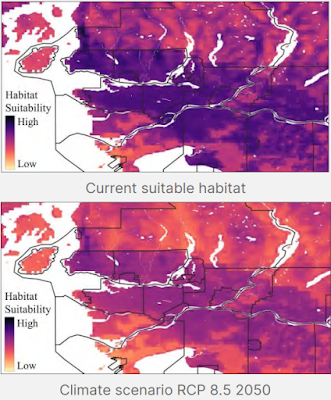When we think of climate change and its impacts on our ecosystems, we likely think of native plant and animal species, but climate change also impacts invasive species. In partnership with UBC and Trinity Western University, the Metro Vancouver Regional District recently completed a mapping exercise of several invasive plant species, plotting out how their range would change by 2050.
They looked at four invasive plant species. Three of the four invasives would benefit from climate change while the other would have a reduction in our region.
The following maps show the changes for these four species.

|
| If Flowering Rush is established in our region, it will proliferate throughout Metro Vancouver if not contained. Currently, it is only in Hatzic. Select map to enlarge. |

|
| Mouse-Ear Hawkweed will reduce in Metro Vancouver due to climate change. Select map to enlarge. |

|
| Climate change will make Shiny Geranium highly suitable for invasion throughout Metro Vancouver. Select map to enlarge. |

|
| Water Hyacinth will likely spread further throughout our region due to climate change. Select map to enlarge. |
As we know, climate change stresses native species and may lead to their extinction over time. Invasives out compete native plants for resources. The replacement of native plants with invasives degrades our ecosystem, creating economic, infrastructure, and human health challenges. Some invasive plants can literally break apart concrete on highways!
This all means that, as a region, we need to double down on our efforts to control the spread of invasive plants. For example, in Langley City, we usually partner with non-profits to set up summer student teams that clear invasives in the Nicomekl Floodplain. City crews target the removal of particularly nasty invasive plants. Over time, we will need to increase City resources to control invasive plants in our community.
Please check out the September 9th Metro Vancouver Climate Action Committee agenda for more information.


No comments:
Post a Comment
All comments are moderated.